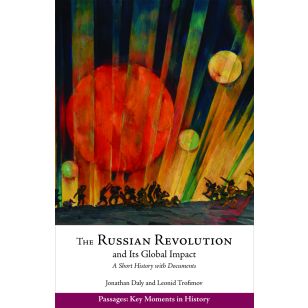The Russian Revolution and Its Global Impact
Series: Passages: Key Moments in History
"Thoughtful, readable, and concise, this little book sets the Russian Revolution in its global context. Though primarily focused on the period from 1917 to the 1930s, it nicely illustrates the many ways in which the effects of the Revolution are still being felt today." —Rex Wade, George Mason University
For more on the 100th anniversary of the Russian Revolution read Jonathan Daly and Leonid Trofimov's post Commemorating the Russian Revolution from Vladimir Lenin to Vladimir Putin on the Hackett Publishing blog, The Hackett Colloquium.
eBook available for $15.50. Click HERE for more information about Hackett eBooks.
For more on the 100th anniversary of the Russian Revolution read Jonathan Daly and Leonid Trofimov's post Commemorating the Russian Revolution from Vladimir Lenin to Vladimir Putin on the Hackett Publishing blog, The Hackett Colloquium.
"On the centenary of the Russian Revolution, Jonathan Daly and Leonid Trofimov have reinvigorated the study of a turning point in world history. Instead of rehashing the internal dynamics of the Bolshevik takeover, the authors have carefully juxtaposed the international ambitions of the Bolsheviks with the Revolution’s reception around the world.
"Daly and Trofimov pair their lucid introductory essay with documents from Soviet officials, intellectuals in South America, W. E. B. Du Bois in the United States, and others, so readers will quickly realize how revolutionary ideas cross oceans and transcend geopolitical boundaries. This volume thus takes a topic once reserved for students of Russian history and places it in a world historical perspective; those interested in global history, European history, and, of course, those fascinated by events in Petrograd and Moscow will find ample sources of inspiration in this text. As the Russian Federation is now exerting its influence on a global scale, the time is ripe to consider the Russian Revolution in such broad terms."
—Nigel Raab, Loyola Marymount University
"Thoughtful, readable, and concise, this little book sets the Russian Revolution in its global context. Though primarily focused on the period from 1917 to the 1930s, it nicely illustrates the many ways in which the effects of the Revolution are still being felt today."
—Rex Wade, George Mason University
Contents:
- Preface, Chronology, Glossary, List of Maps, List of Illustrations
Introduction
- Chapter 1: Russia in Revolution and Civil War
- Chapter 2: The Bolsheviks Engage the World
- Chapter 3: The Russian Revolution and the Power of Communism
- Epilogue
Documents
Section 1: Russia’s Revolutions: From the Collapse of the Monarchy to the Civil War
- 1.1. Konstantin Pobedonoststev Blasts Parliamentarism, the Free Press, and Modern Education
- 1.2. V. I. Lenin, Imperialism, the Highest Stage of Capitalism, 1916
- 1.3. Soldiers Write About the War, 1915–16
- 1.4. Order Number One, March 1, 1917 1.5. An American in Petrograd, Spring 1917
- 1.6. Polish Independence and the Russian Revolution, March–April, 1917
- 1.7. Lenin Calls for a Deepening of the Revolution, April 4, 1917
- 1.8. General Session of the Petrograd Soviet, September 11, 1917
- 1.9. Declaration of the Rights of the Working and Exploited People, January 1918
- 1.10. Mustafa Chokaev, Reminiscences of 1917–18
- 1.11. Aleksandra Kollontai, “Soon!” (in 48 Years’ Time), 1919
- 1.12. Nikolai Bukharin and Evgenii Preobrazhenskii, ABC of Communism
- 1.13. The Fate of Kiev, 1918
- 1.14. The Russian “Internationale,” 1902-1944
- 1.15. Appeal of Rebel Leaders to the Peasant Masses, Late July/Early August 1920
Section 2: The Bolsheviks Engage the World
- 2.1. The Bolsheviks Take Russia Out of World War I, January–March 1918
- 2.2. Soviet Protest against Allied Intervention, June 27, 1918
- 2.3. V. I. Lenin, “A Letter to American Workingmen,” August 20, 1918
- 2.4. Pitfalls of Intervention, 1918–20
- 2.5. Bolshevik Anticipation of a Revolutionary Wave in 1919
- 2.6. Report of the Chief of the International Relations Section of the Comintern, March 1, 1921
- 2.7. Toward World Revolution, July 3, 1921
- 2.8. The Treaty of Rapallo, April 16, 1922
- 2.9. J. Stalin, “The Political Tasks of the University of the Toiling Peoples of the East,” 1925
- 2.10. Bolshevik Influence in China, 1920s
- 2.11. Fighting over the Torch of the Revolution: Trotsky versus Stalin
Section 3: The Russian Revolution and the Power of Communism
- 3.1. John Reed on the Revolution and Socialism, 1919
- 3.2. “Russia Did It,” 1919
- 3.3. Bela Kun, “Discipline and Centralized Leadership,” 1923
- 3.4. Otto Ruhle, “Moscow and Us,” 1920
- 3.5. French Writer Romain Rolland Responds to a Call to Join the Revolutionary Cause, February 2, 1922
- 3.6 Emma Goldman Rejects Bolshevik Policies, 1922-23
- 3.7. “The Russian Problem,” 1919
- 3.8. Hitler’s Lessons from the Russian Revolution, 1923-26
- 3.9. “The Zinoviev Letter” Roils British Politics, 1924
- 3.10. Prime Minister Neville Chamberlain’s unease about Soviet Russia, 1939.
- 3.11. “A Bright and a Heartening Phenomenon in a Dark and Dismal World,” 1933-1936
- 3.12. Josiah Gumede, “The New Jerusalem,” 1927
- 3.13. W. E. B. Du Bois Discovers Soviet Russia (ca. 1928)
- 3.14. José Carlos Mariátegui Welcomes World Revolution
- 3.15. Dr. José Lanauze Rolón’s Radio Address in Puerto Rico Extolls the Russian Revolution, 1936
- 3.16. Mao Zedong’s Retrospective of the Revolutionary Struggle, 1949
Select Bibliography
About the Authors:
Jonathan Daly is Professor of History, University of Illinois at Chicago.
Leonid Trofimov is Senior Lecturer in History, Bentley University.







